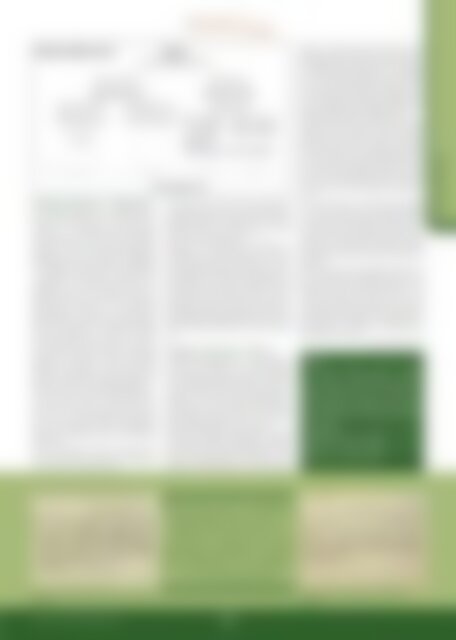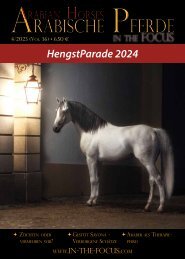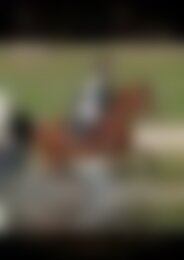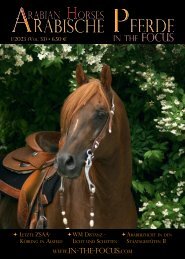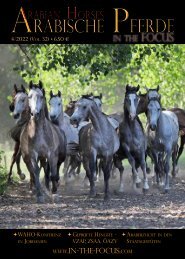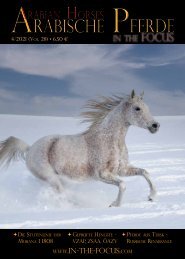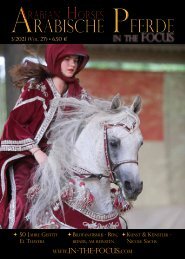Arabische Pferde IN THE FOCUS 1/2022 (Vol. 29) - public
Zeitschrift für Liebhaber und Züchter arabischer Pferde
Zeitschrift für Liebhaber und Züchter arabischer Pferde
Sie wollen auch ein ePaper? Erhöhen Sie die Reichweite Ihrer Titel.
YUMPU macht aus Druck-PDFs automatisch weboptimierte ePaper, die Google liebt.
FORENSIC QUESTION 2<br />
FORENSIC QUESTION 1 - DOKTRYNER<br />
As mentioned before, this technique also<br />
allows us to detect errors – or at least “questionmarks”<br />
– in studbook records many generations<br />
back, two of which we will explain<br />
in detail. The first one concerns the stallions<br />
Doktryner or his son Gerwazy. Doktryners<br />
parentage officially is given as “by Miecznik<br />
out of Blaga”, and horses after Doktryner<br />
– through his son Gerwazy – belong to the<br />
haplotype “Ta-b”. But the dataset also included<br />
samples of descendants of another<br />
Miecznik-son Aquinor, and they belong to<br />
the haplotype “Ao-aA1a*”, i.e. distinctively<br />
different! Also, another line through Fetysz<br />
(the sire of Miecznik) in Trakehner breeding<br />
showed “Ao-aA1a4”. So, the sire line of Fetysz<br />
through Miecznik to Aquinor is identical<br />
with the sire line of Fetysz in Trakehner<br />
breeding, but different to the line through<br />
Miecznik to Gerwazy. A recent inaccurate<br />
paternity assignment of either Doktryner or<br />
Gerwazy is the most probable explanation.<br />
The next step was to look at Doktryners provenance:<br />
He was born in 1950 at Klemensow,<br />
Poland. Assuming that Miecznik is not<br />
his true sire, it was looked at the stallions<br />
that were available in 1949 in Klemensow,<br />
the year of covering Doktryners dam Blaga.<br />
These were:<br />
The list of stallions shows, that there was<br />
only one stallion at stud with the haplotype<br />
“Ta-b”, which is Amurath Sahib.<br />
To double-check when the wrong paternity<br />
assignment occurred, the same was done for<br />
Gerwazy (Doktryner / Gwara) born in 1955 at<br />
Michalow Stud. The stallions active in 1954<br />
(year of covering Gwara) were:<br />
Although the haplotype of Rozmaryn is<br />
unknown, he can be excluded as sire of the<br />
grey Gerwazy, because Rozmaryn is chestnut<br />
and Gwara bay, which cannot result in a<br />
grey offspring. Therefore the haplotypes (in<br />
combination with colour genetics) provide<br />
an indication that Amurath Sahib, active at<br />
Klemensow Stud at the time of covering, was<br />
the biological father of Doktryner. And actually<br />
looking at photographs of Doktryner and<br />
Amurath Sahib makes this even more probable.<br />
FORENSIC QUESTION 2 - SIGLAVY<br />
A different “questionmark” in the pedigrees<br />
concerns the “Siglavys” of various breeds.<br />
So far, pedigree records suggest that Siglavy<br />
db ‘Schwarzenberg’, grey, born 1810, was the<br />
founder of the sire lines in Shagya-Arabians,<br />
Lipizzans as well as Trakehners, while Siglavy<br />
IV db, bay, born 1819, was only active in Shagya-Arabian<br />
breeding, but his line became<br />
extinct already in the 19th century (3).<br />
However, Dr. Wallner and her team detected<br />
two distinct Arabian haplotypes in horses<br />
tracing back to the imported Arabian stallion<br />
Siglavy ‘Schwarzenberg’, 1810 (quote): “The<br />
Lipizzaner and Kladruber lines (after Siglavy<br />
Slavina III, 1893) carried ’Ao-aA1a2’ and the<br />
subline-haplotype ’Ao-aA1a2a’, whereas Shagya<br />
Arabians and Trakehner (after 21 Siglavy<br />
II-2, 1909) grouped distantly into haplotype<br />
’Ao-aA1b‘. Both haplotypes were not detected<br />
in any lines other than the Siglavys. Hence,<br />
the findings indicate that the Siglavy sire<br />
lines in Lipizzaner and Shagya Arabians were<br />
founded by paternally unrelated horses.”<br />
Confusion may have arisen because a second<br />
Siglavy line, founded by the Arabian stallion<br />
Siglavy IV db, 1819 (imp. 1825), was active<br />
in parallel (from 1825 to 1868) to the Siglavy<br />
line after Siglavy db ‘Schwarzenberg’, 1810<br />
in the studs of the Habsburg Monarchy, and<br />
due to the naming system in these studs, the<br />
same name (with differing Roman numbers)<br />
was given to the male offspring of both sire<br />
lines.<br />
It is interesting to note that these different<br />
sire lines in Lipizzaner and Shagya Arabians<br />
also explain the discrepancy pointed out in<br />
our article about the Siglavys (2) and the description<br />
of the painting by Albrecht Adam,<br />
who shows a bay Siglavy as founder stallion<br />
of the Lipizzan breed, which then should be<br />
Siglavy IV.<br />
For the first time, the technique of fine-scaled<br />
Y-chromosmal haplotype analysis was<br />
applied in Arabians, and the findings – especially<br />
when put into historical context – are<br />
convincing. With this technique, a powerful<br />
tool has been developed that provides information<br />
about the origin, purity, genealogies,<br />
distribution and influence of Arabian stallions<br />
and their sire lines.<br />
Gudrun Waiditschka<br />
Sources:<br />
(1) Remer, V.; Bozlak, E.; Felkel, S.; Radovic,<br />
L.; Rigler, D.; Grilz-Seger, G.; Stefaniuk-Szmukier,<br />
M.; Bugno-Poniewierska, M.;<br />
Brooks, S.; Miller, D.C.; et al.: “Y-Chromosomal<br />
Insights into Breeding History and Sire<br />
Line Genealogies of Arabian Horses”. Genes<br />
<strong>2022</strong>, 13, 2<strong>29</strong>. https:// doi.org/10.3390/genes130<strong>2022</strong>9<br />
(2) Waiditschka, G.: “Purity form a genetic<br />
view point”, AP 1/2021, p. <strong>29</strong>ff<br />
(3) Furrer, B.: “The two Siglavys with world<br />
influence”, AP 1/2019, p. 54ff.<br />
Breeding<br />
<strong>THE</strong> LIPIZZANER AND KLAD-<br />
RUBER SIRE L<strong>IN</strong>ES HAVE A<br />
DIFFERENT HAPLOTYPE AND<br />
<strong>THE</strong>REFORE DIFFERENT FOUND-<br />
ERS COMPARED TO <strong>THE</strong> SHAG-<br />
YAS AND TRAKEHNERS.<br />
Pedigree von Kuhailan Afas db im arabischen<br />
Original<br />
1/<strong>2022</strong> - www.in-the-focus.com<br />
53<br />
Übersetzung des Pedigrees von Kuhailan<br />
Afas db.


